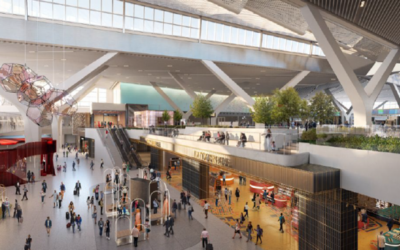Editor’s Note: With the backdrop of increased federal funding for airports under the Bipartisan Infrastructure Law, which provides $5 billion over five years to improve the nation’s aging airport infrastructure, global architecture and design firm Perkins&Will has expanded its transportation planning and design practice. Last year, the firm hired Julie Wienberg, a national leader in aviation architecture, to oversee Perkins&Will’s airport planning and design services. AXN’s Carol Ward connected with Wienberg in October 2023 to discuss her views on evolving terminal design, sustainability and the passenger experience.
Ward: First, can you tell me a bit about your professional history leading up to you taking the role at Perkins&Will?
Wienberg: I joined Perkins&Will on May 1 of 2023. I’ve got about 25 years of experience as an aviation leader in different capacities, most recently leading practices for large architectural firms. I see so much opportunity coming in the industry right now. I think aviation is hotter than it’s ever been in my career all over the world, with the sheer number of projects. I think it’s the age of aviation – everyone is growing or they’re building or they’re renovating. I’m an architect by training. I started out as an architect doing terminal facilities, being the lead project architect. I got into management – I’m sort of self-educated as well as certified to move into program management. For the last 10 years I’ve been doing large airport programs, helping airports implement their capital programs. I’m very excited to be with Perkins&Will, which has more of a global practice, to really learn and get a deeper understanding of the practice all over the world.
Ward: Will your skills be deployed all over the world or are you focused only on North America?
Wienberg: I am the global practice leader. Most of our offices are in North America but we are looking at the practice holistically. Aviation is one of the practices that definitely lends itself to a global approach. I think we’re all learning from each other much faster than ever before.
Ward: Sustainability is a hot topic in aviation these days. what are some of the key challenges your firm is encountering on the sustainability front in terms of design, and how are you addressing those?
Wienberg: Perkins&Will has a really good reputation for decades of investing in and believing in sustainability. We’re seeing that now pay off with the concerns and issues around climate change and resiliency. Honestly, I think resiliency is probably the bigger issue for most airports. Perkins&Will has been looking at the whole system approach. It isn’t just looking at sustainability during design and construction, which is important, but really taking it much farther and looking at the entire approach to the way the airport operates. We look at the way they handle water from its source to its end, and hopefully reuse and recycling. We look at the energy sources at the airport, not just including solar panels, but at the entire system.
A lot of airports are cities unto themselves. They hire and have as many employees as larger municipalities in the regions. They’re often the biggest economic generator for a city or a region. They can stand out as examples of how to do things right, because they are able to really control their destiny and set the precedent for other municipalities in the country. One of the things that excite me around sustainability is being able to really make a difference, not just in the moment at which we’re designing and opening the constructed building, but in the entire way the airport operates.
Ward: Achieving carbon neutral is a goal for virtually every airport. Do you find any reticence in the industry to kind of embrace the approach you talked about? Or is it full speed ahead?
Wienberg: Most of the airports that I’ve worked with really embracing it. It’s about figuring out how each one of them, based on where they are in their capital programs, can implement it. Nearly all of the large hubs and most of the medium hub airports have fairly large capital programs. I am seeing a really exciting and encouraging trend where they are evaluating their sustainability goals and guidelines. Most of them are going through significant updates to stay abreast of current technology and current reporting structure.
Ward: Regarding the traveler experience, what trends are you seeing in airport design?
Wienberg: I’ve been very, very impressed with some of the recent solicitations at large airports that are wanting to either remodel or build new terminals. They’re really starting to pay attention to the infrastructure and the back of house. So often we get so focused on the front of house – how it looks and feels to the customer – that we don’t invest or pay enough attention to how it operates back of house. Some put new concessions in but they don’t really have the infrastructure – the delivery corridors, the screening of goods, the ability to deliver goods – to serve the customers. Airports are realizing if they want to have this fabulous customer experience and this fabulous non-airline revenue offering, they have to be able to support that from the back and really pay attention to storage needs, delivery needs, as well as staffing needs.
Being able to get the support staff and employees in and out of the airport and give them a good work environment is also important. It can’t be entirely public facing all the time – that can be exhausting. I’m seeing the airlines really take this seriously because they’ve struggled with recruiting and retention, and we see a lot of workplace development happening where they’re providing nice amenities to the employees of the airlines in the airports. They have nice breakrooms; they have places to retreat for rest and relaxation. They’re making the journey to the work better – either paying for parking or they’re providing public transportation. There’s a growing understanding that the user [of the airport] is the employees as well as the passengers.
Also, I think airports are starting to evaluate themselves not just as a service for getting people and bags to planes, but as being destinations in and of themselves. I see a lot of airports now, if they have the space, providing amenities to the landside so that you have the travelers and the meter and greeters or the community able to come together. It’s about being the front door to the community, creating a destination.






